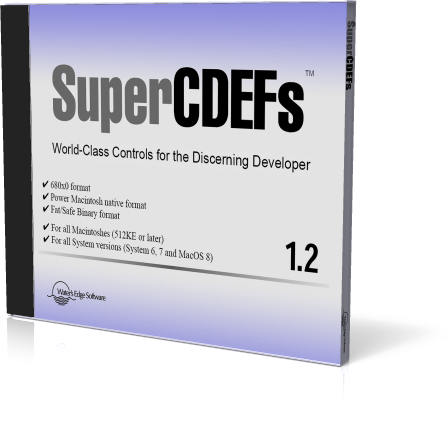
Overview of SuperCDEFs
SuperCDEFs is a collection of professionally designed and crafted controls that give your application the finishing touch it needs for a polished "3D look," with or without the Appearance Manager. These attractive controls can be used in conjunction with Apple's standard controls, or to replace them. Five types of controls are included: Buttons, tabs, sliders, thermometer, and a hierarchy triangle, as seen in the Finder.
The collection includes buttons that are as subtle as a standard color radio button, except with a white control center (Apple's radio buttons and check boxes are filled with the control's background color resulting in a less defined appearance). SuperCDEFs also has boldly shadowed 3D buttons with raised or inset 3D titles. Check boxes have an additional "undefined" state (a dash in the box), and when selected, they can display a programmer-specified custom icon in place of the "x" in the check box. Fourteen different button styles are available in 3D and flat variations.
Tabs, like those seen on file folders, are new user interface elements that are appearing in many new applications. SuperCDEFs offers a variety of tabs ranging from delicate to daring, and they can be attached by any side (left, top, right, and bottom) of a panel. Nine different tab CDEFs are available, in 3D and flat variations.
SuperCDEFs also includes much sought-after slider controls. Eleven variations are available, including sliders that look like audio mixer faders. These sliders can be used in real time, with or without an action proc, making them the simplest way to implement sliders in an application. SuperCDEFs' sliders use a proprietary "smart scaling" algorithm to ensure that tick marks and their corresponding numeric scale (if one is displayed) are always legible and attractive, even when the scale is compressed due to space constraints.
3D push buttons and tabs incorporate animation effects to make them look like they are being pressed into the window when the user clicks them.
All SuperCDEFs are shipped in 680x0 format, Power Macintosh native format, and Fat/Safe Binary format that combines both 680x0 and Power Macintosh native code, in one resource. They run on all Macintosh models (512KE or later), Power Macintosh and Mac-OS compatibles, and all system versions (System 5 or later). A one-time low-cost license covers unlimited royalty-free distribution of applications created using SuperCDEFs.
What kinds of developers need SuperCDEFs?
Any or all of the following:
- Commercial developers who don't have the time, resources, or inclination to create professional-looking controls themselves.
- Developers who need the finishing touch for a complete "3D look" interface.
- Someone who needs sliders and/or tabs, controls that are not provided by Apple on Macs that are not equipped with the Appearance Manager (pre MacOS 8).
- Developers who have tried shareware or freeware controls and have been disappointed, or are ready for top-notch controls used by professionals.
- Someone who wants to retain a traditional Macintosh interface, but with a few minor changes to clean up Apple's shortfalls.
- Someone who wants the absolute best in CDEFs.
- Someone who may be on a tight budget.
Some SuperCDEFs Examples
The following is just a small sample of the types of controls, the versatility, and the notable appearance, which are available in SuperCDEFs:
 |
3D Control with Flat Title
|
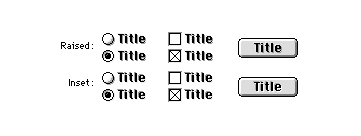 |
3D Control with 3D Title
|
 |
Exploring Your OptionsYou can get a variety of different looks from a single CDEF, just by using a different color scheme. In this example, we use a strongly shadowed 3D control with strongly shadowed 3D text. This works well on these small buttons because we've used lighter colored text instead of the traditional black. |
 |
Mini 3D Control with Flat Title
|
 |
Variable corner roundness in all push buttonsThe roundness of the push button's corners is automatically calculated using the same formula that Apple uses, so any code you have to draw a default button frame around the button will still work perfectly. If you want a slightly different look, SuperCDEFs also let you specify the degree of roundness in the corners. |
 |
Push buttons that look like they're being pushed!All our 3D push buttons appear as though they are being pushed into the window when the user clicks them. This example shows a 3D push button with 3D text in its standard unselected state (top), and as it is being selected by the user (bottom). Notice that the 3D text retains its raised character, even when the button is highlighted. |
 |
Sliders in various styles, and optionsSuperCDEFs includes 11 styles of sliders, with options such as:
|
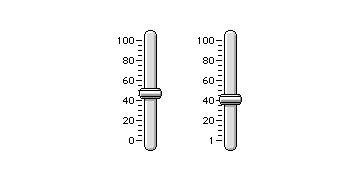 |
Tick marks and scaleOur sliders can optionally display tick marks along one or both sides of the slider. If the tick marks get too close together to be aesthetically pleasing, "smart scaling" draws tick marks in intervals (e.g., count by 2's, 5's, 10's, 25's etc.) When this is the case, your slider's indicator may rest between two tick marks. Sliders can also have numeric values displayed along with the tick marks on the scale. "Smart scaling" ensures that numbers are spaced in a manner that is both logical and attractive. This example shows two sliders whose scales have been compressed with "smart scaling" — Tick marks in increments of 5, and values in increments of 20. Note the right slide correctly starts its value at the programmer-specified "1" rather than the default "0" (left). |
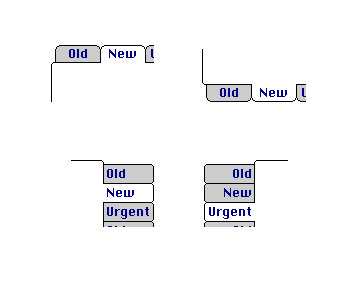 |
Attach tabs to any side of your paneMost tabs can only attach to the top of a pane. SuperCDEFs' tabs let you attach them to any side of your pane, top, bottom, left, or tight, for the ultimate in versatility. The tabs in this example are the simple flat control with flat title. |
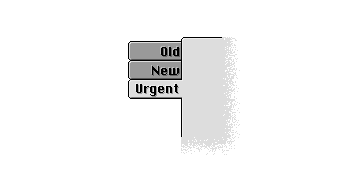 |
Wide variety of custom appearancesYou can get a wide variety of appearances by using different style SuperCDEFs in combination with different colors. This example uses a heavily shadowed 3D control with softly shadowed 3D text. The main page and selected tab use a medium gray. The unselected color was automatically darkened by the CDEF because it was also set to the same medium gray. The title and frame are both black and the window's background color is a light gray. As you can see, the look is clean, it retains much of Macintosh's character, yet it has an exciting "3D look." |

